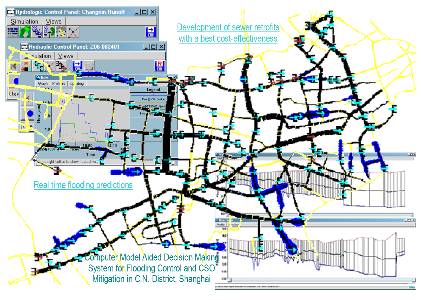
Computer Analysis Tool of Hydrosims
SewerSIMs
The first sewer model using general flow governing equations was called
Storm Water Management Model (SWMM), which was sponsored by the US
EPA in the early 1970’s. The majority of the sewer modeling community has
considered the hydraulic simulation engine in SWMM and its principles as a
Standard approach.
The SWMM Extran is a major model component for hydraulic simulations of
sewer network. The numerical method used in the Extran needs user to have
significant experiences in “model polishing” in order to overcome the
numerical instability often occurred in the model simulations, especially for
those large and complex sewer systems. The earlier SWMM could only be
operated within the DOS operating system and had no user interface.
Using principles similar to SWWM, SewerSIMs consists of St. Venant
equations, i.e. 1-D momentum and continuity equations. The strength of
SewerSIMs is its very robust simulation process due to the application of the
latest numerical approach and a user-friendly interface. The model package
development was mainly sponsored by Shanghai Municipal Sewerage
Company during 1997 ~ 2004.
SewerSIMs
The first sewer model using general flow governing equations was called
Storm Water Management Model (SWMM), which was sponsored by the US
EPA in the early 1970’s. The majority of the sewer modeling community has
considered the hydraulic simulation engine in SWMM and its principles as a
Standard approach.
The SWMM Extran is a major model component for hydraulic simulations of
sewer network. The numerical method used in the Extran needs user to have
significant experiences in “model polishing” in order to overcome the
numerical instability often occurred in the model simulations, especially for
those large and complex sewer systems. The earlier SWMM could only be
operated within the DOS operating system and had no user interface.
Using principles similar to SWWM, SewerSIMs consists of St. Venant
equations, i.e. 1-D momentum and continuity equations. The strength of
SewerSIMs is its very robust simulation process due to the application of the
latest numerical approach and a user-friendly interface. The model package
development was mainly sponsored by Shanghai Municipal Sewerage
Company during 1997 ~ 2004.



Click image for large view
SewerSIMs




| |||||||
Copyright © 2005-2008 Hydrosims. All rights reserved.


